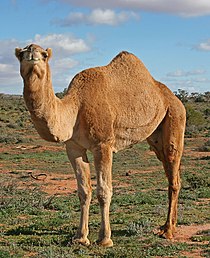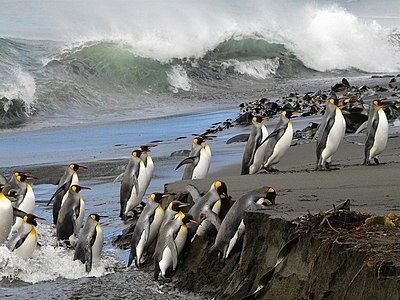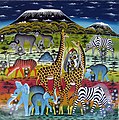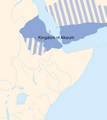Portal:Africa

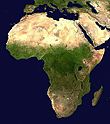

Africa is the world's second-largest and second-most populous continent after Asia. At about 30.3 million km2 (11.7 million square miles) including adjacent islands, it covers 20% of Earth's land area and 6% of its total surface area. With nearly 1.4 billion people as of 2021, it accounts for about 18% of the world's human population. Africa's population is the youngest among all the continents; the median age in 2012 was 19.7, when the worldwide median age was 30.4. Based on 2024 projections, Africa's population will reach 3.8 billion people by 2099. Africa is the least wealthy inhabited continent per capita and second-least wealthy by total wealth, ahead of Oceania. Scholars have attributed this to different factors including geography, climate, corruption, colonialism, the Cold War, and neocolonialism. Despite this low concentration of wealth, recent economic expansion and a large and young population make Africa an important economic market in the broader global context. Africa has a large quantity of natural resources and food resources, including diamonds, sugar, salt, gold, iron, cobalt, uranium, copper, bauxite, silver, petroleum, natural gas, cocoa beans, and.
Africa straddles the equator and the prime meridian. It is the only continent to stretch from the northern temperate to the southern temperate zones. The majority of the continent and its countries are in the Northern Hemisphere, with a substantial portion and a number of countries in the Southern Hemisphere. Most of the continent lies in the tropics, except for a large part of Western Sahara, Algeria, Libya and Egypt, the northern tip of Mauritania, and the entire territories of Morocco and Tunisia, which in turn are located above the tropic of Cancer, in the northern temperate zone. In the other extreme of the continent, southern Namibia, southern Botswana, great parts of South Africa, the entire territories of Lesotho and Eswatini and the southern tips of Mozambique and Madagascar are located below the tropic of Capricorn, in the southern temperate zone.
Africa is highly biodiverse; it is the continent with the largest number of megafauna species, as it was least affected by the extinction of the Pleistocene megafauna. However, Africa also is heavily affected by a wide range of environmental issues, including desertification, deforestation, water scarcity, and pollution. These entrenched environmental concerns are expected to worsen as climate change impacts Africa. The UN Intergovernmental Panel on Climate Change has identified Africa as the continent most vulnerable to climate change.
The history of Africa is long, complex, and varied, and has often been under-appreciated by the global historical community. In African societies the oral word is revered, and they have generally recorded their history via oral tradition, which has led anthropologists to term them oral civilisations, contrasted with literate civilisations which pride the written word. During the colonial period, oral sources were deprecated by European historians, which gave them the impression Africa had no recorded history. African historiography became organized at the academic level in the mid-20th century, and saw a movement towards utilising oral sources in a multidisciplinary approach, culminating in the General History of Africa, edited by specialists from across the continent. (Full article...)
Selected article –

Alodia, also known as Alwa (Greek: Αρουα, Aroua; Arabic: علوة, ʿAlwa), was a medieval kingdom in what is now central and southern Sudan. Its capital was the city of Soba, located near modern-day Khartoum at the confluence of the Blue and White Nile rivers.
Founded sometime after the ancient Kingdom of Kush fell, around 350 AD, Alodia is first mentioned in historical records in 569. It was the last of the three Nubian kingdoms to convert to Christianity in 580, following Nobadia and Makuria. It possibly reached its peak during the 9th–12th centuries when records show that it exceeded its northern neighbor, Makuria, with which it maintained close dynastic ties, in size, military power and economic prosperity. Alodia was a large, multicultural state administered by a powerful king and provincial governors appointed by him. The capital Soba, described as a town of "extensive dwellings and churches full of gold and gardens", prospered as a trading hub. Goods arrived from Makuria, the Middle East, western Africa, India and even China. Literacy in both Nubian and Greek flourished. (Full article...)
Featured pictures –
Did you know (auto-generated) -

- ... that Kobe and Vanessa Bryant were founding donors of the National Museum of African American History and Culture?
- ... that Ngiam Tong Dow negotiated Singapore's first and largest purchase of gold from South Africa in 1968 by comparing two halves of a United States one-dollar bill?
- ... that one way to tell the African dusky flycatcher apart from the ashy flycatcher is that the former is "cuter"?
- ... that after erecting the African Union headquarters, the Chinese government was accused in 2018 of spying on the building for five years?
- ... that the Bethel African Methodist Episcopal Church in Springtown, New Jersey, was used by Harriet Tubman to help fugitive slaves escape?
- ... that nursing educator Helen Turner Watson was one of the first African-American women to become a commissioned officer in the United States Navy?
Categories
Selected biography –
Fatima Massaquoi-Fahnbulleh (/ˈmæsækwɑː/; 25 December 1911 – 26 November 1978) was a Liberian writer and academic. After completing her education in the United States, she returned to Liberia in 1946, making significant contributions to the cultural and social life of the country.
Born into a family of African royalty, Massaquoi grew up in the care of an aunt in Njagbacca, in the Garwula District of Grand Cape Mount County of southern Liberia. After seven years, she returned to the northwestern part of the country in Montserrado County, where she began her schooling. In 1922 she accompanied her father, a diplomat, to Hamburg, Germany, where she completed her school education and started a course in biology at the University of Hamburg. In 1937 she moved to the United States for further education, studying sociology and anthropology at Lane College, Fisk University and Boston University. While in the US, she collaborated on a dictionary of the Vai language and wrote her autobiography, though a legal battle ensued over the rights to her story. She won an injunction barring others from publishing it, and returned to Liberia in 1946, immediately beginning collaboration to establish a university there, which would become the University of Liberia. (Full article...)
Selected country –
 |
 |
|

| ||
Equatorial Guinea, officially the Republic of Equatorial Guinea, is a country in Central Africa. One of the smallest countries in continental Africa, Equatorial Guinea comprises a mainland territory known as Río Muni (including several offshore islands), the island of Bioko (formerly Fernando Pó), where the capital Malabo (formerly Santa Isabel) is located, and the island of Annobón in the South Atlantic Ocean. It is bordered by Cameroon on the north, Gabon on the south and east, and the Gulf of Guinea on the west, where the island nation of São Tomé and Príncipe is located.
Formerly the Spanish colony of Spanish Guinea, its post-independence name is suggestive of its location near both the equator and the Gulf of Guinea. It is the only country in mainland Africa where Spanish is an official language, excluding the Spanish exclaves of Ceuta and Melilla, and the UN-recognised but Moroccan-occupied Sahrawi Arab Democratic Republic (Western Sahara). The discovery of sizeable petroleum reserves in recent years is altering the economic and political status of the country. (Read more...)
Selected city –
Casablanca (Arabic: الدار البيضاء, romanized: al-Dār al-Bayḍāʾ, lit. 'the White House', IPA: [adˈdaːru ɫbajdˤaːʔ]) is the largest city in Morocco and the country's economic and business centre. Located on the Atlantic coast of the Chaouia plain in the central-western part of Morocco, the city has a population of about 3.22 million in the urban area, and over 4.27 million in Greater Casablanca, making it the most populous city in the Maghreb region, and the eighth-largest in the Arab world.
Casablanca is Morocco's chief port, with the Port of Casablanca being one of the largest artificial ports in Africa, and the third-largest port in North Africa, after Tanger-Med (40 km (25 mi) east of Tangier) and Port Said. Casablanca also hosts the primary naval base for the Royal Moroccan Navy. (Full article...)
In the news
- 18 January 2025 – 2025 Suleja fuel tanker explosion
- At least 77 people are killed and several others are injured when a fuel tanker overturns on a highway in Suleja, Niger State, Nigeria, and later explodes when people gather to collect the spilled fuel. (Vanguard) (The Straight Times)
- 17 January 2025 –
- Three people are killed and seven others are injured in clashes with security forces in Juba and Aweil, South Sudan, with three Sudanese-owned houses set on fire in Aweil. This comes after videos emerged allegedly showing Sudanese soldiers killing South Sudanese civilians in Wad Madani, Sudan. (BBC News)
- 16 January 2025 – Somali Civil War, War against the Islamic State
- The Puntland Security Force claims to have captured a training facility used by ISIL militants, with over forty ISIL fighters killed following heavy fighting. (The Eastleigh Voice)
- Thousands of families are displaced as the military campaign intensifies, forcing locals to flee their homes in Bari region of Puntland, Somalia. (Idil News) (Horn Observer)
- 16 January 2025 – Red Sea crisis
- The leader of the Houthis Abdul-Malik al-Houthi announces that the group will monitor the implementation of the Israel–Hamas ceasefire agreement and continue its attacks on vessels and on Israel if the ceasefire is breached. (Middle East Monitor)
- 16 January 2025 – Sudanese civil war
- The U.S. Treasury Department sanctions the head of the Sudanese Armed Forces Abdel Fattah al-Burhan for "destabilizing Sudan and undermining the goal of a democratic transition" to a civilian-led government. (BBC News)
Updated: 3:05, 19 January 2025
General images -
Africa topics
More did you know –
- ... that Liberia College in the country of Liberia was authorized by the legislature in 1851, but did not start classes until 1863?
- ... that the forced removal of 700,000 people from slums in Zimbabwe in 2005 was called "a crime against humanity" by the UN?
- ... that the supreme god of the southern African Bushmen is Cagn, a trickster who shapeshifts into a praying mantis?
- ... that Bahá'í Faith in Niger began during a period of wide scale growth in the religion across Sub-Saharan Africa near the end of its colonial period?
Related portals
Major Religions in Africa
North Africa
West Africa
Central Africa
East Africa
Southern Africa
Associated Wikimedia
The following Wikimedia Foundation sister projects provide more on this subject:
-
Commons
Free media repository -
Wikibooks
Free textbooks and manuals -
Wikidata
Free knowledge base -
Wikinews
Free-content news -
Wikiquote
Collection of quotations -
Wikisource
Free-content library -
Wikispecies
Directory of species -
Wikiversity
Free learning tools -
Wikivoyage
Free travel guide -
Wiktionary
Dictionary and thesaurus




